Tue 9 Dec 2008
Archived Mystery.File Review: BOB McKNIGHT – Running Scared.
Posted by Steve under Authors , Bibliographies, Lists & Checklists , Characters , Crime Fiction IV , Reviews[4] Comments
BOB McKNIGHT – Running Scared.
Ace Double D-469; paperback original; 1st printing, 1960.
I meant to say something about George Harmon Coxe’s “workmanlike” prose in my recent review of Murder for Two, but it could be said just about as well right here. [The phrase is a common one; Google just a moment ago produced about 3000 hits.] What I mean by the term is this: a style of writing that you just don’t notice.
Nothing so fancy as to call attention to itself, although as a standard that’s hardly enough. It can’t be anything other than a subjective assessment, one that varies from person to person.
Nonetheless, assuming that there is such a concept, I think that “workmanlike prose” was more common with writers whose background was working for the pulp magazines. Writers whose job it was to tell a story, to get on with it, before their readers got bored and went on to something else.
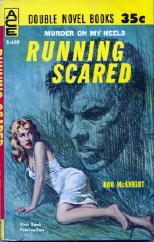
Coxe was such a writer. Frank Gruber was another. The most famous was probably Erle Stanley Gardner. None would get much of notice for their writing from a professor of literature, but because they were good writers, they captured the reader’s attention from page one onward.
Although I don’t believe he ever wrote for the pulps. He came along a little too late for that. He was a paperback writer. He never had a book come out in hardcover, so in the overall scheme of things he’s on a far lower scale than either a Gardner or a Coxe, who both made it big. But a storyteller? Yes.
The plot of Running Scared is that of your basic, everyday nitwit hero in a not quite everyday basic situation. He’s the kind of guy who has reasons for not calling the cops on page two — for if he had, there would be no story. He watches a murder take place, committed by someone driving his ex-wife’s car, and then he gets a call warning him that she has reported the car stolen. By him.
He goes to her apartment (after being beaten up by two hoods on the way), befriends another girl there, hides her in a bathroom hamper when the cops come calling, and then finds her shot to death inside the hamper when the cops leave.
I am not making this up. Actually, it reads very well. McKnight had the knack of making you believe nonsense like this all the while you realize that it is nonsense. Workmanlike prose, remember? One could easily picture an Alan Ladd or a Dick Powell in the leading role.
But in the end, this is about all there is to say about the book. The pace is terrific, and I guarantee you that once stated, you will keep reading. Unfortunately, I cannot tell you that there is any overall depth to either the characters or the story. It’s too lightweight to be considered memorable, and the non-meticulous details of the plot are exactly that.
What Running Scared is, though, is fun to read.
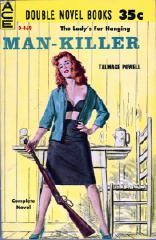
[UPDATE] 12-09-08. My comments on the other half of this Ace Double will be posted here shortly. For the record, it is Man-Killer, by Talmage Powell, an author who really did start out writing for the pulp magazines before shifting into a career, mystery-wise, of mostly paperback originals.
As for Bob McKnight, here below is a complete list of his novel-length mystery fiction, as compiled in the Revised Crime Fiction IV, by Allen J. Hubin. Surprisingly enough to me, when I wrote this review I obviously didn’t recognize PI Nathan Hawk as being in this book and as being a series character. I thought so little of him, apparently, that I didn’t even mention his name. (I don’t think he was the main protagonist, but perhaps he was.)
And as long as I’ve brought him up, Nathan Hawk is included in Kevin Burton Smith’s website devoted to Private Eye fiction. He says, in part: “Tough guy eye NATHAN HAWK, transplanted northerner in Sun City, Florida, shot and slugged his way through ten novels published by ACE in the late fifties and early sixties. Detective Lieutenant Toby Duane lends a hand when he can, and dishes out plenty of friendly ‘damn yankee’ jibes along the way.”
Running Scared is the only one of McKnight’s books I’ve ever read. Even though my judgment was qualified, I’m a sucker for books with wacky openings like this, even if the endings don’t pan out so well in comparison. Given an opportunity, I absolutely would read another.
McKNIGHT, BOB. 1906-1981. Mining engineer, pilot and horse-racing handicapper before semi-retiring to Florida.
Downwind (n.) Ace Double D-217, 1957 [Santa Fe, NM]
Murder Mutuel (n.) Ace Double D-279, 1958 [Nathan Hawk; Florida]
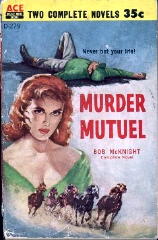
The Bikini Bombshell (n.) Ace Double D-387, 1959 [Nathan Hawk; Florida]
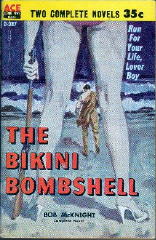
Swamp Sanctuary (n.) Ace Double D-411, 1959 [Florida]
Kiss the Babe Goodbye (n.) Ace Double D-447, 1960 [Nathan Hawk; Florida]
Running Scared (n.) Ace Double D-469, 1960 [DELETE Nathan Hawk; ADD setting: Florida (St. Petersburg)]
Secret Sinners (n.) Merit 35, 1960 [Nathan Hawk; Florida]
A Slice of Death (n.) Ace Double D-419, 1960 [Florida]
Drop Dead, Please (n.) Ace Double D-511, 1961 [Florida]
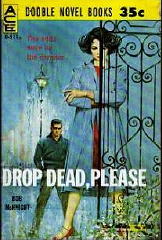
The Flying Eye (n.) Ace Double F-102, 1961 [Florida]
A Stone Around Her Neck (n.) Ace Double F-143, 1962 [Nathan Hawk; Florida]
Homicide Handicap (n.) Ace Double F-229, 1963 [Nathan Hawk; Florida]
December 9th, 2008 at 8:28 pm
Steve: You’re right about the pace in Bob McKnight’s books, they are fast. And they had to be because I believe some barely reached 100 pages in those ACE Doubles. I’ve always enjoyed the author and was more fond of the non-Nathan Hawk novels. Did some postings myself on a couple of his paperbacks and it’s nice to see his name mentioned. A author with talent, that has become rarely known now.
My favorite is still the first novel of McKnight’s that I read, “Kiss the Babe Goodbye”
http://vinpulp.blogspot.com/2007/12/kiss-babe-goodbye-by-bob-mcknight_18.html
December 9th, 2008 at 8:41 pm
August
I didn’t think to look, but you’re right. Running Scared is only 111 pages long. About the same length as a Robert B. Parker novel, but McKnight doesn’t have the same number of fans as Spenser and Jesse Stone do, and never did.
— Steve
PS. Don’t get me wrong. While I haven’t read any of his books in the last 10 or 15 years, I’m a Parker fan, too.
December 9th, 2008 at 9:00 pm
Hey, I just turned my wife on to the Jesse Stone novels and today she came back from the library with two more. Well to be honest, it was really the Tom Sellock made-for-TV movies featuring Parker’s Stone that turned her on. (she was a big Thomas Magnum fan) But at least she is reading mysteries instead of her usual Danielle Steele novels.
Your McKnight posting made my day.
Have a great night Steve.
December 10th, 2008 at 5:40 pm
[…] [The other half being Bob McKnight’s Running Scared, and you can find my comments here.] […]